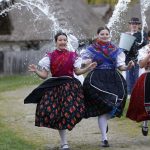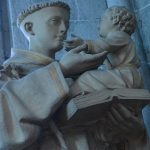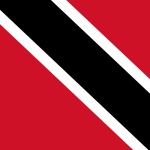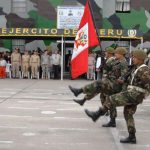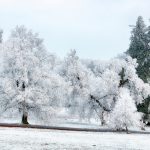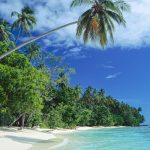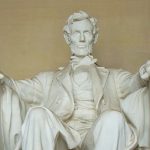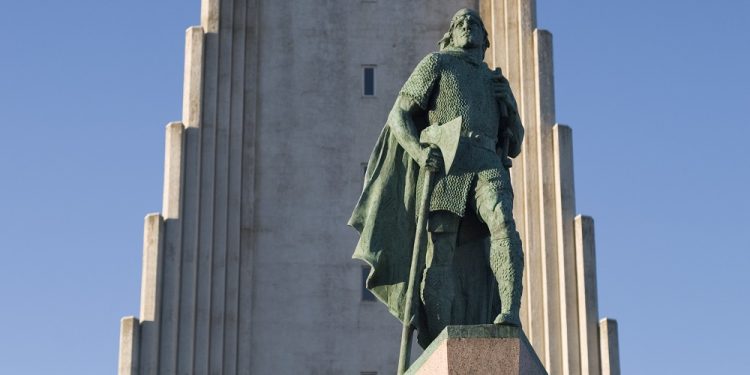
Leif Erikson Day
Leif Erikson Day is an observance day that falls annually on October 9th. Leif Erikson was a Norse explorer who is believed to be the first European to set foot on North American soil. However, the date for this holiday wasn’t chosen because this is when he landed in North America or for any reason concerning Leif Erikson whatsoever.
The 9th of October was chosen because that’s the day on which the first organized immigration from Norway to the U.S. began back in the early 19th century.
The History Of Viking Exploration Of North America
In 1874, a book by Norwegian-American author and professor called “America Not Discovered By Columbus” was published. This book popularized the idea that Christopher Columbus wasn’t the first European to set foot on North American soil but that it was indeed the Vikings who could make the claim.
This was later verified in 1960 when L’Anse aux Meadows—an archaeological site of an 11th-century Norse settlement—was discovered. If the Sagas of Icelanders are to be believed, Norsemen from Iceland first settled in Greenland at the end of the 10th century.
Erik the Red was banished from Iceland for manslaughter and decided to explore the southwestern coast of Greenland during the first three years of his banishment. At the time, these areas were uninhabited.
He decided to establish a settlement there and named the area Greenland because he felt that more people would come if the area had a good name. An area located at the inner portion of a fjord was named Eiriksfjord in his honor. He would establish the Brattahlid estate and issue tracts to those who followed him.
According to various Icelandic sagas, including the Saga of the Greenlanders and Eirik The Red’s Saga, the Norse began to explore lands west of Greenland almost immediately after setting up settlements. In 985, a merchant named Bjarni Herjólfsson was blown off course, along with a migration fleet of approximately 700 settlers and 25 other ships.
After three days, they sighted land west of their fleet. He would later describe what he found to Leif Erikson. Leif Erikson would explore the area further and approximately 15 years later would plant a settlement. According to the sagas, three distinct areas were explored.
These included “Land Of The Flat Stones” (Helluland); “Land Of Forests” (Markland); and “The Land Of Wine” (Vinland). In 1001, Leif Erikson used the landmarks described by Bjarni to head west from Greenland across the Labrador Sea. He had a crew of 35 people and in 1001 wintered near Cape Bauld on the northern tip of Newfoundland.
The Norse continued to establish settlements in North America, and historians believe that the Norse could have maintained trade for lumber and furs with indigenous peoples for up to 400 years.
Leif Erikson Day Versus Christopher Columbus Day
When it was first learned that North America was initially discovered by the Norse instead of Christopher Columbus, it came at a time of intense anti-Italian sentiment. As a veritable flood of Italian immigrants entered the United States at the end of the 19th and the beginning of the 20th centuries, many Americans began to resent them.
Some Americans began to blame the new Italian immigrants for all of the country’s ills. It was around this time that Americans first began to consider Leif Erikson as a holiday over Christopher Columbus Day.
Around 1876, the Roman Catholic organization known as the Knights Of Columbus, along with several other Italian-American groups, began to lobby Congress to recognize Columbus Day as a holiday. In 1907, Columbus Day was established as a holiday in Colorado, and in a few years, it was adopted by 15 different U.S. states.
The anti-Italian sentiment of the time and anti-Catholic paranoia did motivate many different groups to advocate for a Leif Erikson Day. Unfortunately, it never gained momentum in the same way as Columbus Day.
Leif Erikson Day almost became a forgotten holiday, even though it’s been a national day of observance since the mid-1950s — meaning that the U.S. President makes a proclamation about it every year.
Why did Columbus Day win over Leif Erikson Day? Well, it’s mainly due to the diligent lobbying that Italian Americans made on behalf of Columbus Day. It’s also due to the fact that Christopher Columbus had more of an impact on immigration to the U.S. than Leif Erikson did.
On the other hand, some people would say that it really doesn’t matter who “discovered” America. After all, both Christopher Columbus and Leif Erikson were people who found places that already had millions of people living there, so in effect, neither one of them discovered it.
Fun Facts About Leif Erikson
We’re going to make a pretty big assumption and assume that if you’re reading about this holiday, then you’re probably interested, at least a little bit, in Leif Erikson. So we thought it would be a good idea to list some facts about Leif Erikson, the Vikings, and anything else that we think is pertinent to this holiday.
Leif’s Name Is Pronounced In Different Ways
Anyone wanting to know how to pronounce Leif Erikson’s name probably isn’t going to get much help with this section. That’s because it’s pronounced in several different ways depending on where you live or what language you’re saying it in. In Iceland and parts of Scandinavia, Leif is normally pronounced “Layf.”
This can sound like “safe” or “life” depending on what parts of those countries you’re from. If you’re an American, then you’ll probably pronounce the name as “leaf.” So it’s up to you how you’re going to pronounce this explorer’s name.
Leif Might Not Have “Discovered” North America
Debate over whether Leif Erikson or Christopher Columbus discovered North America has raged on for over 100 years, the fact of the matter is that these two explorers were probably beaten by a third party by several hundred years. It might have been an Irish monk known as Saint Brendan the Navigator who died around 577 CE.
According to a Latin-language biography known as The Voyage Of St. Brendan, the monk found a beautiful island while setting a boat to the sea to look for the Garden of Eden. Some historians think this beautiful island is actually Newfoundland, but there isn’t any solid proof of that fact.
The Vikings Left A Lot Of Mysteries Behind
Even though historians have found proof that the Vikings were in North America, there isn’t a whole lot of information known about what they did in the Americas. According to the Sagas, the Vikings headed south after they left Helluland.
They then stopped at “The Land of Forests” or Markland. Markland is supposed to be south of Helluland and north of Vinland – the area where Leif and his men set up camp. It’s known that Greenlanders continued to visit Vinland through the 14th century, but there are no details about where it’s located.
According to the Sagas, Vinland had a lot of grapevines, which is why it was given the name Vinland, but also had salmon, wild grasses, and plenty of game animals.
Unfortunately, historians have no idea where Vinland was located or why the Vikings stopped going to Vinland. Some historians believe that L’Anse aux Meadows might be Vinland, but others aren’t so sure.
Native North Americans And Vikings Didn’t Always Interact Peacefully
Even though there may have been some level of cooperation between Vikings and the native Americans whom the Nordics called Skraelings, the fact of the matter is that not all interactions between the two groups were peaceful.
According to the Sagas, the Vikings were attacked by Native Americans using advanced weapons such as catapults. In another story, it’s mentioned that Leif’s brother Thorvald was killed near Vinland by a native warrior. So it’s obvious that not all interactions between the two groups were in the spirit of cooperation.
Leif Had Several Sons
The one thing that we know about Leif is that he had two sons. On one of his voyages to join up with Olaf Tryggvason, Leif Erikson’s crew became lost. As a result, they ended up landing on the Hebrides near Scotland.
Because of terrible weather, he and the crew had to stay there for an entire month, and during the course of this time, he ended up getting a lord’s daughter pregnant. He then went back to Norway and left the woman and the child behind.
However, when he received word that the child was born a boy, he decided to raise him and christened him Thorgills Leifson. Thorgills lived with Leif in Greenland. Later on, Leif would have another son whom he named Thorkel. As far as historians know, those are the only children he’s known to have had.
It’s Believed That Leif Stopped At Baffin Island
Some historians believe that Leif Erikson ended up stopping at Baffin Island – the largest island in Canada. That’s because according to The Saga of the Greenlanders, he discovered an icy land that was filled with large, flat rocks that he named Helluland.
According to the ancient Norse, this island was called a stone-slab land, a description that makes historians think that he stopped at Baffin Island. After all, there have been some Norse artifacts found there and this 932-mile island does contain a rocky terrain that fits the description in the Sagas.
Leif Erickson Day Is Proclaimed Annually
Since the mid-1950s, Leif Erikson Day has been proclaimed as a holiday to honor Scandinavian Americans every year on October 9th. However, there has been no national push to make Leif Erikson a permanent holiday either on the state level or the federal level.
